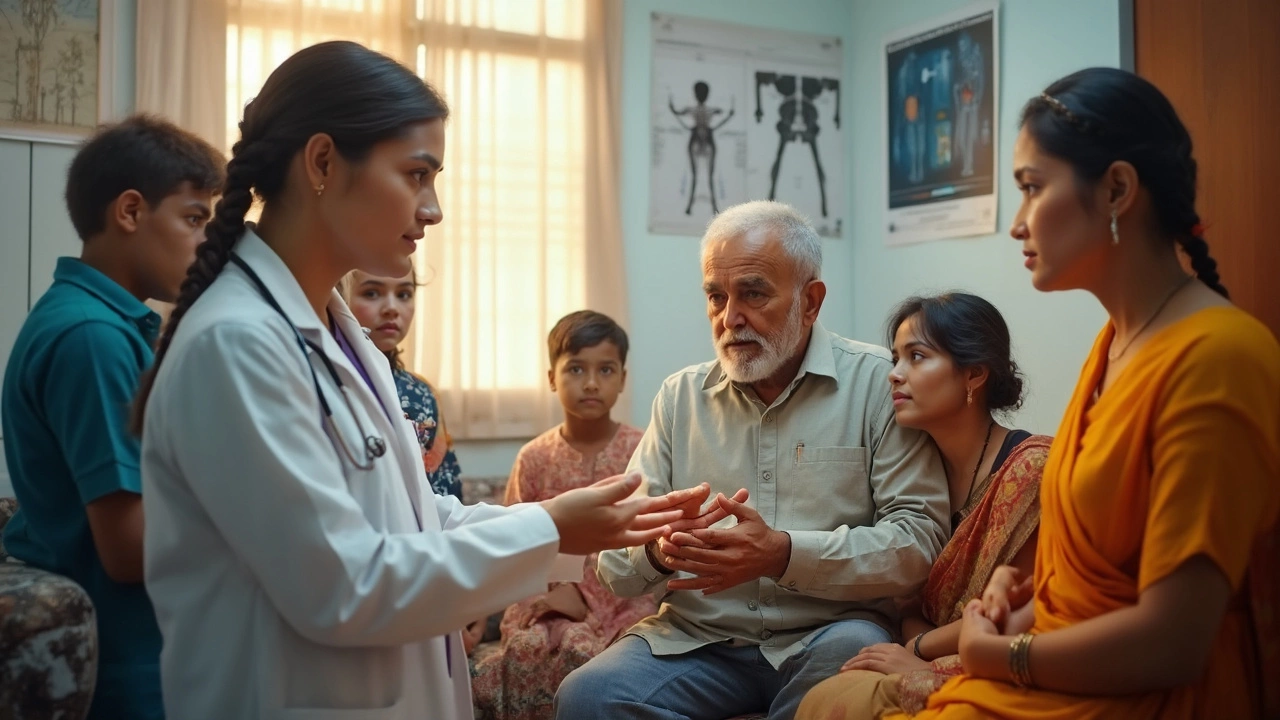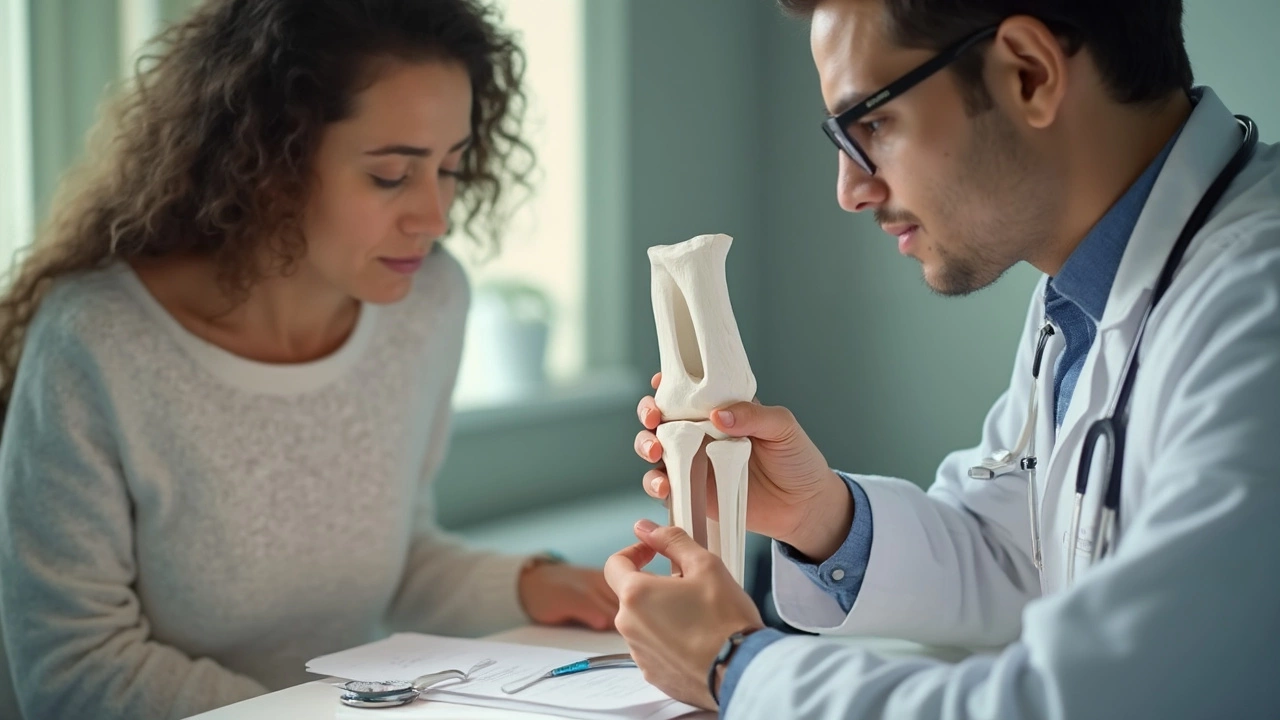
If you've ever asked yourself, "Can an orthopedic doctor really tell if I have arthritis?" the short answer is yes, and here's why that matters. Orthopedic doctors aren't just focused on broken bones. They're actually the go-to experts for anything that messes with your joints, muscles, and bones—including arthritis, which is one of the most common reasons people show up at their clinics.
Most folks think arthritis is just 'old people's joint pain.' Not true. Arthritis can strike at just about any age, and it's more complicated than doctors just poking your knee and saying, "Yep, that's arthritis." Ortho docs use a blend of your story, a good exam, and sometimes high-tech tests to get a clear picture. Knowing what to expect during a visit and what questions to ask can make all the difference if you're worried about your aching joints.
- Who Is an Orthopedic Doctor?
- How Arthritis Shows Up in Your Body
- What Happens at the Doctor's Visit?
- Tests Orthopedic Doctors Use to Diagnose Arthritis
- Tips for Managing Arthritis with Your Ortho
Who Is an Orthopedic Doctor?
An orthopedic doctor is the specialist people see when their body's hinges—joints, bones, and muscles—start acting up. They spend years studying how the whole musculoskeletal system works and what happens when things go wrong, like with arthritis or sports injuries. You don’t have to be an athlete to need one—these doctors see everyone from school kids with sprains to grandparents with stiff knees.
Want some hard numbers? Orthopedic doctors usually go through about 14 years of training. That’s four years in college, four years in medical school, five years of residency, plus extra time if they want to super-specialize (think sports medicine or joint replacement).
| Training Stage | Years |
|---|---|
| College | 4 |
| Medical School | 4 |
| Residency | 5 |
| Fellowship (optional) | 1-2 |
On top of all this, orthopedic docs need to keep learning new stuff all the time. New treatments and tools come out every year, so they keep their skills sharp with ongoing courses and real-world training.
When it comes to diagnosing something like arthritis, orthopedic doctors don’t just rely on X-rays. They listen to your story, look for patterns, check how your joints move, and ask about your daily life. They know a lot about every kind of joint—from the tiny ones in your fingers all the way to your hip or spine. That wide experience is what makes them the right people to figure out what’s up with your achy joints, whether it’s early arthritis or something else entirely.
How Arthritis Shows Up in Your Body
Arthritis doesn’t always come in loud and obvious. Sometimes it creeps in with morning stiffness, aching joints, or weird popping sounds. If you feel pain or swelling in areas like your knees, fingers, or even your spine—especially when you first wake up or after sitting for a while—that’s often how it starts.
The most common kinds are osteoarthritis and rheumatoid arthritis. Osteoarthritis usually kicks in after years of wear-and-tear, like a squeaky door hinge that never got oiled. Rheumatoid arthritis is different—it’s an issue with your immune system getting confused and attacking your joints. That can lead to redness, warmth, and pain around multiple joints, even if you’re fairly young.
Here’s a quick comparison of what people usually notice with the two main types:
| Type | Main Signs | Who Gets It |
|---|---|---|
| Osteoarthritis | Pain worsens through the day, stiffness after rest, possible grinding feeling | Usually over 40, but can happen younger after injury |
| Rheumatoid Arthritis | Stiffness lasts over an hour in the morning, swelling in many joints, fatigue | Often starts between ages 30-60, more common in women |
Watch out for these common signals something’s up with your joints:
- Pain with movement or even at rest
- Joints that look swollen or red
- Hard to bend or straighten a joint all the way
- Joints feel warm to the touch
- Clicking or grinding sounds when you move
If joint pain keeps showing up and doesn’t quit after a few days, don’t ignore it. The sooner a orthopedic doctor gets involved, the easier it is to manage symptoms and slow down the damage.

What Happens at the Doctor's Visit?
Walking into an orthopedic clinic isn’t as intimidating as it seems, especially if you know what’s coming. The first thing the doctor does is sit down and actually listen. They'll ask exactly where it hurts, how long it’s been going on, whether it’s stiffness or swelling, and if it gets better or worse as the day goes on. They’ll want to know if running, climbing stairs, or even simple things like opening a jar give you trouble.
After that, comes a hands-on check. The doctor looks for lumps, swelling, changes in skin color, or anything that looks off in the joint. They’ll probably move your arm, leg, or fingers around, checking how much you can move without pain. Sometimes the doctor might press on certain spots to check for tenderness.
Don’t be surprised if the questions get personal. You might get asked about family history because things like arthritis often run in families. You might also hear questions about your everyday routine, past injuries, or other health problems you have.
- You don’t need to have all the answers or even remember every ache, but giving honest details helps your orthopedic doctor rule out other problems and zero in on what's really going on.
- If you’ve already tried things like over-the-counter pain meds or ice packs, tell the doctor. It gives them a better sense of how serious your symptoms are.
- Bring along a list of your medications if you take any, and note any allergies—sometimes treatment for arthritis needs to be tailored around these details.
Most first visits end with next steps: blood tests, X-rays, or even an MRI if things aren’t clear yet. If the doctor suspects arthritis, these tests help confirm the diagnosis and show how much joint damage, if any, has already started. The whole process is about getting a clear answer, not just guessing and hoping for the best.
Tests Orthopedic Doctors Use to Diagnose Arthritis
When you meet an orthopedic doctor about arthritis, they're not just guessing based on what you say. They follow a checklist of tests—some old-school, some pretty high-tech—to figure out exactly what's going on inside your joints. Here’s the practical breakdown of what usually happens.
First, the doctor will probably start with a physical check. They’ll ask you to move around, bend your joints, or push against their hands. This helps them spot swelling, tenderness, or unusual sounds that could signal arthritis.
But to get a real look at the inside of your joints, ortho docs rely on a mix of the following tests:
- X-rays: Pretty much the first scan they’ll order. X-rays show bone damage, loss of space between joints, and sometimes new bone growth—signs that often point to arthritis.
- MRI (Magnetic Resonance Imaging): Used when X-rays don't show enough. MRIs pick up early-stage changes in soft tissue and cartilage, which is key for spotting problems you can’t see on an X-ray.
- Blood Tests: Not all arthritis is the same. Some types, like rheumatoid arthritis, show certain markers in the blood. Docs might test for things like rheumatoid factor (RF), anti-CCP, and inflammation levels (ESR, CRP).
- Joint Fluid Analysis: This sounds odd, but sometimes they pull a bit of fluid from your joint with a tiny needle. This test can show if the problem is arthritis or something else, like an infection or gout.
- Ultrasound: Handy for checking real-time inflammation and spotting swelling in joints that are hard to see on X-ray, like in your hands or feet.
You might wonder, "Why not just use one test?" Because different types of arthritis show up in different ways. For example, osteoarthritis usually shows joint space narrowing on X-ray, while inflammatory types might need a blood test to be sure.
Check out the table below for a quick cheat sheet on what these tests reveal:
| Test | What It Shows | Useful For |
|---|---|---|
| X-ray | Bone damage, joint space loss | Osteoarthritis |
| MRI | Soft tissue and cartilage changes | Early or subtle arthritis |
| Blood Test | Markers of inflammation or autoimmunity | Rheumatoid or autoimmune arthritis |
| Joint Fluid Analysis | Infections, uric acid, crystals | Gout, infection vs. arthritis |
| Ultrasound | Real-time joint swelling and inflammation | Hand/foot arthritis, early detection |
If you get sent for these tests, it’s not a wild goose chase—it’s about ruling stuff out and picking the right treatment. Don’t be shy about asking your ortho why they’re ordering a certain test. It’s your body, and understanding each step makes the road to better joints way less confusing.

Tips for Managing Arthritis with Your Ortho
Working with an orthopedic doctor isn't just about getting a diagnosis. It's about building a plan that helps you live better with arthritis—because let's face it, joint pain is a daily hassle. Here are solid ways to get the most out of your visits and keep your joints moving longer.
- Be Honest About Your Pain: Don’t downplay your symptoms. Tell your ortho exactly when it hurts, what makes it better or worse, and how it affects your day.
- Track Your Progress: Keep a simple pain diary or use your phone to note flare-ups. Bring these notes to appointments. It helps the doctor see patterns and tweak your treatment faster.
- Ask About Non-Drug Treatments: Orthos aren’t just about pills or surgery. They know about physical therapy, exercise plans, and even simple lifestyle tweaks that can help you move better.
- Get Moving (Safely): Studies show that low-impact activity—think swimming or cycling—can ease stiffness and reduce pain in people with arthritis. Your doctor can suggest safe exercises based on your joint health.
- Don’t Skip Appointments: Arthritis changes over time. Even if you start to feel better, skipping follow-ups can mean missing a big change that needs attention.
If you ever get confused about new terms or treatment options, ask for explanations in simple language. Your ortho can break down even the most high-tech jargon, but only if you speak up.
Here’s a quick look at what most orthopedic doctors recommend for managing arthritis day to day:
| Management | How It Helps |
|---|---|
| Physical Therapy | Improves mobility, reduces pain |
| Weight Loss (if needed) | Eases stress on joints, especially knees and hips |
| Medications | Reduces inflammation and pain |
| Exercise | Boosts joint flexibility |
| Assistive Devices | Makes daily activities easier |
Remember, your ortho’s job is to give you real solutions, not just throw technical terms at you. Bring real questions, take notes, and stay active in your own care. It makes a bigger difference than you might expect.





Rohan Talvani
I am a manufacturing expert with over 15 years of experience in streamlining production processes and enhancing operational efficiency. My work often takes me into the technical nitty-gritty of production, but I have a keen interest in writing about medicine in India—an intersection of tradition and modern practices that captivates me. I strive to incorporate innovative approaches in everything I do, whether in my professional role or as an author. My passion for writing about health topics stems from a strong belief in knowledge sharing and its potential to bring about positive changes.
view all postsWrite a comment